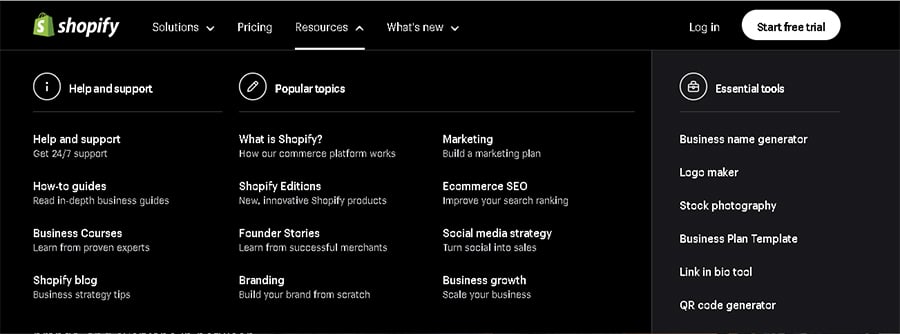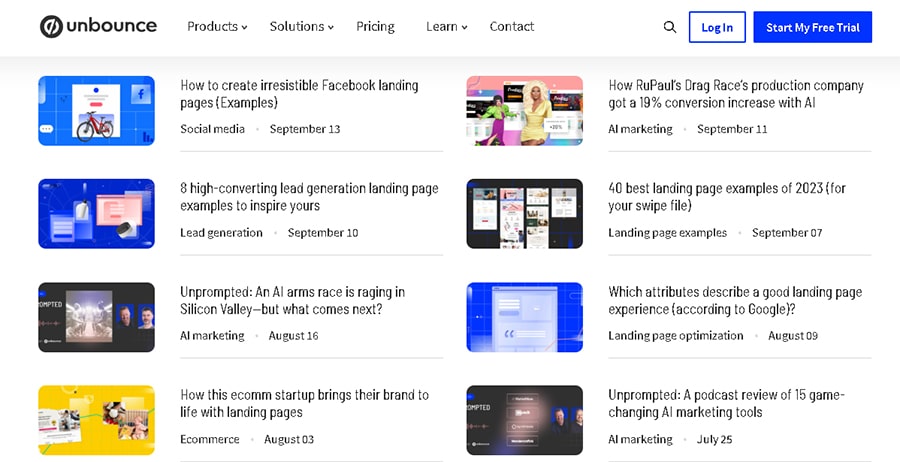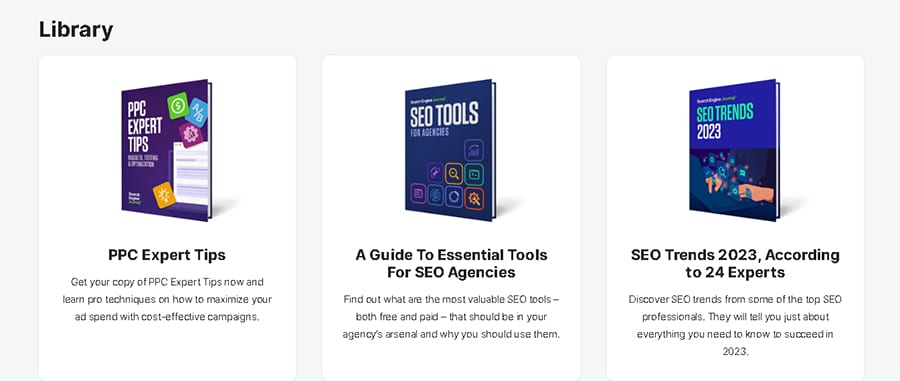Table of Contents
The Ultimate Guide To Understanding B2B Content Marketing

No matter the industry you belong to or the audience you want to target, there’s one universal truth: you can’t ignore the need for B2B content marketing strategies if you want other companies to trust you and do business with you.
However, I know you may be wondering precisely what content marketing is or what key elements you need to consider when developing your strategy. Don’t worry, I’m here to help 😉.
In this article, I’ll tackle all the basics you should know about B2B content marketing: what it is, its benefits, how to create your own strategy, and I’ve even added some examples so you can see what it looks like in practice!
Now, without further ado, let’s jump right in.
What Is Content Marketing?
This type of marketing focuses on consistently creating and sharing relevant, valuable, and useful information with your audience. The content you put out has the power to attract and retain new customers and engage and keep current ones interested in your brand.
Content marketing has one crucial characteristic you should always keep in mind: the content you publish isn’t meant to be a sales pitch. Rather, the idea behind it is to engage and retain new and prospective clients and build long-lasting relationships with them.
You’ve probably heard of B2C content marketing, which aims at engaging individual customers and creating an emotional connection to get them to buy a specific product. B2B content marketing, on the other hand, is all about showcasing your skill and expertise to other businesses, organizations, or professionals through authoritative material. Here, the goal is to increase your audience’s trust in you, and convince them to partner with your business.
The Benefits of Content Marketing for B2B Businesses
Many benefits come with developing a solid content marketing strategy; let’s take a look at some of them:
- Help your SEO efforts. Creating authoritative content and using the right keywords significantly increase your chances of ranking higher in the SERPs and driving organic traffic to your website. What’s more, it can also help you earn backlinks from other sites, another SEO essential.
- Aid in all stages of the Buyer’s Journey. Each different type of content is designed for a specific purpose, like increasing awareness or encouraging purchase decisions, meaning that content marketing can be successfully implemented throughout the three stages of the Buyer’s Journey.
- Educate your audience. Since B2B content marketing is mainly leveraged to build brand awareness and establish your business as a field expert, the content you put out serves to educate your target audience about your brand and the solutions you offer. Additionally, it can help inform their purchase decisions or even influence stakeholders.
- Invest in a cost-effective tactic. Unlike paid advertising, content marketing is often a budget-friendly marketing strategy. Sure, you’ll need to spend a bit on content creation tools, or maybe partnering with a content marketing agency if you’d rather leave it to the experts, but the end product has a long shelf life and can achieve great results for several months.
- Spread the word about your products and services. Even the most niche or complex products can be marketed through a well-thought-out content strategy. And, if that wasn’t enough, you can do so in a format that is easy to understand for your audience and also highly shareable across all your communication channels.
How to Create a B2B Content Marketing Strategy
I’m sure you’ve been looking forward to this section, so I won’t keep you waiting. Let’s break down the steps and best practices to develop your own content marketing plan:
1. Identify Your Audience
The whole point of a content marketing strategy is to reach your intended market to let them know you’re aware of their needs and pain points, and show them that you have the perfect solution for them. That’s why the first step of any strategy is to conduct some thorough research about your target audience.
You can use Google Analytics to get a look at the demographics of your website’s visitors: age, gender, language, country, and more. To get these insights, click on “Reports” > “User” > “User Attributes” > “Overview.” This information will be highly valuable when deciding the tone and voice of your content and determining if, for example, you may need localization or translation services for a foreign audience.
2. Carry Out a Content Audit
Before you set out to create a whole truckload of new content, take a look at what you’ve already published to know how you can improve or build upon it.
A content audit will allow you to check what types of content are performing well, and which ones might be underperforming or have become outdated. This way, you’ll know what to put out more of and what to improve or change altogether.
You can resort to Google Analytics once again to perform a free audit. Click on “Reports” > “Life cycle” > “Engagement” > “Pages and screens” to see some key metrics about your pages, like views, views per user, average engagement time, and conversions.
3. Research The Competition
Unless you’re in a super specific niche, chances are you have hundreds of competitors out there fighting to grab your audience’s attention.
So, researching what the competition is doing right (and what it’s doing wrong!) can be an excellent way to discover what you can improve in your own strategy, as well as get inspiration for new content that hasn’t yet been explored by others. It’s also a helpful tactic to better determine what sets you apart from the rest and build your brand identity around that unique voice.
4. Define Your Goals
In order to stay on track and have a clearly defined strategy, you need to establish the goals you want your content to achieve. Do you need to boost brand awareness? Rank higher in the SERPs? Convert leads? Maybe all of the above?
Defining your goals may seem simple enough at first glance, but you need to keep in mind that they should be SMART —Specific, Measurable, Achievable, Relevant, and Time-Bound. In other words, this means that you should set precise and realistic goals, which you can achieve in a specific amount of time and which can be measured in terms of performance.
5. Keep Accessibility in Mind
One of the main best practices when it comes to content marketing is to be mindful of accessibility. Even if the majority of your audience doesn’t have visual or auditory impairments (which you can’t really know for sure, to be honest), it’s always good to consider those who do have them.
For example, using large, high-contrast fonts in your blog posts, adding alt-text to your images, or embedding your own subtitles to any video content you upload are just a few accessibility tips that can make your pieces better for those who need them. Or, in case you’re hosting a webinar, for example, you can hire a sign language interpreter for your Deaf or Hard of Hearing audience.
6. Measure Your Results
One awesome attribute of B2B content marketing is that you can keep an eye on its performance in real time. In fact, you can know if your content is achieving the expected results by checking Google Analytics or other similar software, and then replace or improve the piece accordingly.
Decide the metrics you want to focus on (like traffic or conversions) and monitor them regularly to know whether you’re on the right track. If you’re just starting out, I suggest you check your metrics weekly and compare the audits, but you can start doing it bi-weekly or even monthly once you’ve found out what works best for your business.
7. Keep a Content Calendar
Finally, I strongly suggest you set up a content calendar to keep track of everything that has been published and the content that’s still pending. Even if you create awesome pieces, they won’t perform very well if they’re not published following a consistent scheme.
Keeping a calendar means that you’ll have an organized schedule to follow, ensuring there aren’t weeks where you put out 5 pieces of content and weeks where you’re MIA. Likewise, there may be days when you’re so overwhelmed with other tasks that brainstorming that week’s content is impossible, so it’s good to plan ahead and be prepared.
There’s no one-size-fits-all answer regarding the pace at which you should post —what matters is that you keep things consistent and sustainable.
B2B Content Marketing Examples
As I mentioned earlier, the most popular types of B2B content are authoritative pieces that display your expertise and educate your audience. This translates into blog posts, infographics, white papers, webinars, eBooks, and case studies as your best choices when developing ideas for your strategy.
Let’s analyze some examples, so you can learn from the best out there:
1. Shopify – Resource Hub
Shopify is one of the biggest eCommerce platforms out there. Nonetheless, they still share tons of useful information to keep attracting new partners and delighting their current ones.
Their resource hub is full of different B2B content marketing examples: how-to guides, blog posts, online courses, and even free tools for up-and-coming businesses that help with logo-making and name ideas.
I think this is a prime example of content marketing done right. No matter how big or successful your business is, you should always consider your client’s needs and pain points a top priority and strive to provide a solution to them.
2. Mattermark’s Webinar
Mattermark, a data and analytics company, helps venture capital businesses discover and keep track of growing start-ups with their innovative software.
In addition to offering a 14-day free trial, they’ve posted a half-hour webinar tackling the basics of how to use their software for sales. This way, prospects who are on the fence about partnering with Mattermark can get insights into how everything works, try it out, and make an informed purchase decision.
Just like in this example, remember to provide value to your prospective customers, even if they aren’t sure about becoming paying clients yet. What’s more, this type of educational content is also useful for current customers who might need a hand with the technical side of things.
3. Unbounce’s Blog Posts
Unbounce is a landing page software and AI copywriting business. This doesn’t mean they stop there, though, as their blog posts tackle other related topics such as conversion rates, eCommerce, design, and more.
By posting authoritative content on diverse subjects, the team established Unbounce as an expert voice that other businesses can trust when they need information. Writing blog posts also represents an opportunity to let your creativity flow and connect with your audience on a more personal level, expressing your thoughts and opinions on industry topics.
So, think about the solutions your brand provides. Beyond the business transaction, these solutions can be made into informative, valuable content that your prospects and current clients need (and appreciate), saving both of you time and resources with a simple click.
4. Search Engine Journal’s eBooks
It’s not easy to ignore Search Engine Journal’s eBooks when they’re marketed as “38 must-read free eBooks”. Talk about catching your audience’s attention!
Much like blog posts, this B2B content marketing example is used to position your business as an industry expert and build a positive reputation. However, the key difference here is that you can expand on the topic at hand and delve into more detail than you usually do with the average 1500-word blog post.
Since the B2B world is all about nurturing relationships with other businesses, an eBook is the perfect piece of content: your audience gets to know your brand and what you do better, and in exchange, you get their contact information 😃.
Wrapping Up
Well, that’s it for now! I hope you found this guide useful.
B2B content marketing is something no business can afford to ignore, and it’s definitely one of the most important marketing strategies you can implement!
I know developing your own pieces of content may feel daunting. After all, there’s a lot of decision-making involved, and tons of research is required to find out the best types of content for your business and your target audience. However, I assure you it’s all very worth it!
Now that you’ve read all about this type of marketing and seen some inspiring examples, you’re more than ready to start brainstorming your next content strategy. I’m sure it’ll be awesome 😉.










